The flow restrictor is nothing but a filter or net that is attached to an aerator.
It has many holes that break the water stream into smaller streams through which more air can enter and helps to perceive the required water pressure.
The flow restrictor prevents the water to splash out and gives the water stream a shape while coming out of the faucet sprout. It helps to produce a straight and evenly pressured stream.
But due to the minerals or any residue or debris present in the water or pipelines, this screen gets blocked and eventually reduces the water pressure.
So to get rid of this problem, we have to remove flow restrictor from the kitchen faucet and clean it and again put it back on the faucet.
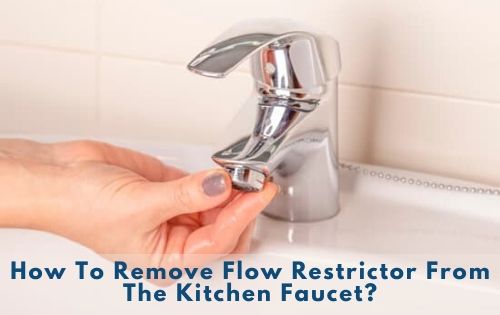
Now the question arises:
Table of Contents
- 1 How to Remove Flow Restrictor From The Kitchen Faucet?
- 2 Risks Of Removing The Flow Restrictor
- 3 How To Remove Aerator From Delta Faucet?
- 4 How To Remove Flow Restrictor From Delta Kitchen Faucet?
- 5 How To Remove Water Saver From Kitchen Faucet?
- 6 How To Remove Flow Restrictor From Pull-Down Kitchen Faucet?
- 7 Types Of Faucets
- 8 Troubleshooting Tips
- 9 Conclusion
- 10 YOU MAY ALSO LIKE
- 11 FAQ’s
- 11.1 How To Remove Flow Restrictor From Pfister Kitchen Faucet?
- 11.2 Is The Flow Restrictor Difficult to Remove?
- 11.3 Does The Flow Restrictor Easily Break?
- 11.4 Why Would I Want To Remove The Flow Restrictor From My Kitchen Faucet?
- 11.5 Can I Remove The Flow Restrictor From Any Type Of Kitchen Faucet?
- 11.6 Will Removing The Flow Restrictor Damage My Faucet?
- 11.7 How Can I Minimize Water Wastage If I Remove The Flow Restrictor?
How to Remove Flow Restrictor From The Kitchen Faucet?
The answer is simple, you don’t need any special plumbing tools to do that. Just turn the aerator counterclockwise direction and remove it. After that, just press the center with your thumb, and the flow restrictor will come out. Remove the washer and again press a little bit, the screen will also come out. Clean it and again put it back. That’s it.
For a complete guide, please refer to the steps below.
But if it’s not clear, then you can follow the step-by-step process that I have discussed below with pictures.
According to Federal and State Law, since 1994, the manufacturers had to add flow restrictors to the faucet to conserve water.
Home Water Works conducted a survey and got that the average or the standard water flow for a kitchen faucet is 2.2 gallons per minute (GPM) without compromising its performance.
That’s why manufacturers put the aerator to conserve water without compromising your desired flow.
Now, follow the steps:
What You Will Need?
- Towel or Silicone Jar Lid (basically to hold the aerator).
- Adjustable Wrench or Pliers (only needed when you can’t open with your fingers).
- Screwdriver.
All the items mentioned here are not essential. It may require if your aerator got stuck and not opening with your fingers.
Step 1: Remove The Aerator
First, try to turn the aerator in a counterclockwise direction with your bare hand. In most cases, it gets removed.
But if it is slippery or you can’t apply pressure then you can take the silicone jar lid or towel and try to remove it.
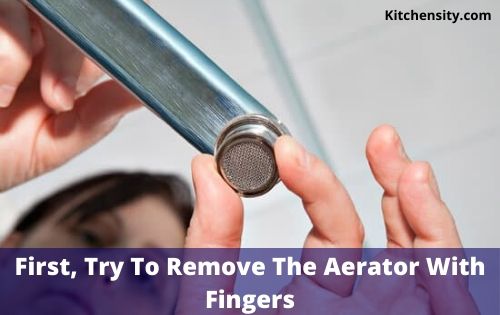
If both cases failed, then you take the adjustable wrench or pliers to remove the aerator. But keep in mind, don’t apply excess pressure, this might scratch your faucet or even break it.
So to keep the faucet safe, do one thing, wrap the aerator with any towel or cloth or plastic tubing whatever is available, and then grab the wrench or plier to take off. Apply gentle pressure and your job will be done.
Important: What if my aerator is concealed (inside the faucet)? This case applies to newer faucets or brands like Delta. So, to remove the aerator you have to use a special tool that can open it. No worry you can easily get on Amazon or any nearby shop. If you want you can here at Amazon. (There are four keys for all faucet sizes).
Step 2: Remove The Flow Restrictor
After you removed the aerator, you can see the dirt particles above the screen.
First, remove the washer and clean the aerator in the running water. Before cleaning put a towel or cloth on the sink to block the holes so that it can prevent the loss of any screws or small items.
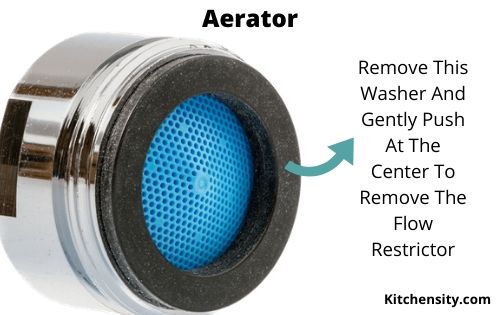
Now, push gently with your thumb at the center of the aerator and this will force the flow restrictor to come easily.
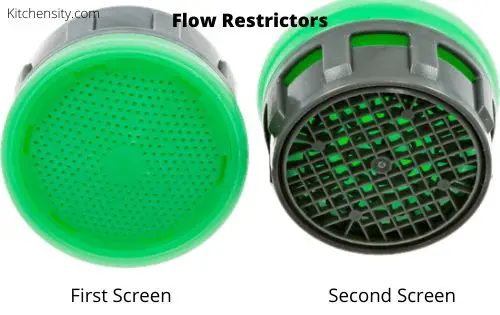
You will notice there are two screens, below and above the restrictor where one is metallic and the other is some sort of plastic net.
But remember the position of how it was placed because you have to put it back exactly in the same order.
Take a toothbrush and clean both the nets, aerator, and also the faucet. If there is too much dirt or rust then you dip the parts in a vinegar solution for 2 hours. This will ease your cleaning process.
If you are not satisfied with the cleaning and want to make sure there is no dirt left inside the flow restrictor then you have to open it.
To open the flow restrictor, take a screwdriver, and gently try to open the nets from the corners. But make sure you don’t break it and remember the order because it’s very important to put it back exactly in the same order.
You May Also Like: How To Remove Kitchen Faucet Without Basin Wrench?
After opening it, you can clean it nicely and again attach the nets. I am not recommending this process as the parts are very delicate and you may end up breaking.
When I tried this first time, I end up breaking and had to replace it with a new one. But eventually, I learned by trying and now I am not breaking it :-).
Step 3: Connect To The Faucet
After cleaning the aerator, flow restrictor, and all its parts, it’s time to attach it back. But before attaching, remove the towel or cloth that you have placed on the sink and run both the cold and hot water tap.
First, run the cold water tap for 15-20 secs and then the hot water tap for 15-20 secs. This will clear the debris or dirt that is present in the pipes.
If you notice dirt or brown water coming out from the faucet then you run the water for more time until it becomes transparent.
After all this work, now you can attach the parts according to the position and connect the aerator to the faucet and run the water.
You will notice the flow restrictor will work fine and you will get the required water pressure. That’s it !!!
You May Also Like: 6 Pull-Out Spray Kitchen Faucet Problems
Risks Of Removing The Flow Restrictor
Removing the flow restrictor from a kitchen faucet can also have some potential risks that should be considered before taking any action.
- One of the primary risks is the increased water wastage that can occur without the flow restrictor.
- The unrestricted flow of water can lead to higher water bills and increased water usage.
- Another risk associated with removing the flow restrictor is that it can put more pressure on your home’s plumbing system, especially if you have older pipes that are more prone to leaks and other issues.
- This can result in costly repairs and maintenance work in the long run.
To minimize the risks of removing the flow restrictor it’s essential to take steps to reduce water wastage.
This can be achieved by turning off the faucet when not in use, fixing any leaks, and installing low-flow aerators that still allow for improved water pressure while using less water overall.
Alternatively, instead of removing the flow restrictor, you can consider replacing the entire faucet with a new one that is designed to provide high water pressure without using excessive amounts of water, making it a more environmentally-friendly option overall.
It is important to weigh the risks and benefits of removing the flow restrictor from your kitchen faucet before making any changes.
While improved water pressure may be desirable, it is crucial to prioritize water conservation and minimize potential damage to your plumbing system.
How To Remove Aerator From Delta Faucet?
Here are the steps to remove the aerator from a Delta faucet:
- Turn Off The Water Supply: Before you start working on your faucet, turn off the water supply to avoid any unwanted leaks.
- Remove The Aerator: Locate the aerator at the end of the faucet and wrap a cloth around it to avoid scratches. Use pliers or an adjustable wrench to turn the aerator counterclockwise until it comes loose. If the aerator is too tight, try using a little bit of WD-40 or vinegar to loosen it up.
- Clean The Aerator: Once you have removed the aerator, clean it thoroughly by rinsing it under running water. If there is any buildup, use a brush to remove it.
- Reinstall The Aerator: After cleaning, reinsert the aerator into the faucet and tighten it by turning it clockwise. Use pliers or an adjustable wrench to snug it up, but do not overtighten it as this may cause damage to the aerator or faucet.
- Turn On The Water Supply: Finally, turn on the water supply and test the faucet to ensure that there are no leaks and that the water flows smoothly.
By following these simple steps, you can easily remove and clean the aerator of your Delta faucet.
How To Remove Flow Restrictor From Delta Kitchen Faucet?
To remove the flow restrictor from a Delta kitchen faucet, follow these steps:
- Turn Off The Water Supply: Before you begin, turn off the water supply to the faucet. This is usually done by turning the valves located under the sink clockwise.
- Remove The Aerator: The aerator is usually located at the tip of the faucet and can be removed by twisting it counterclockwise with your hand or using pliers.
- Disassemble The Aerator: Once the aerator is removed, disassemble it by separating the different components. Look for the small rubber gasket or screen that is the flow restrictor.
- Remove The Flow Restrictor: Use a flat-head screwdriver or needle-nose pliers to carefully remove the flow restrictor from its housing. Be careful not to damage the screen or the gasket.
- Reassemble The Aerator: Once the flow restrictor is removed, reassemble the aerator by putting all the components back together in the right order.
- Reinstall The Aerator: Twist the aerator back onto the faucet in a clockwise direction. Be careful not to overtighten it, as this can damage the threads.
- Turn On The Water Supply: Finally, turn on the water supply and test the water pressure. If the pressure is still low, you may need to clean the aerator or check for other issues with the faucet.
Note: The process of removing the flow restrictor from a Delta kitchen faucet may vary depending on the model and type of faucet.
Delta faucet mostly comes with a concealed aerator. So, to remove the flow restrictor from the Delta kitchen faucet, first, try with your nail to open it. Then remove the restrictor, clean it, and again put it back.
If it is not removed with your nail then you have to get the right tool for that, which is easily available on the amazon. Check It out here.
If you are unsure about the process or encounter any problems, it is always best to consult the manufacturer’s manual or seek professional help.
You can check this video for reference:
How To Remove Water Saver From Kitchen Faucet?
Removing the water saver from a kitchen faucet can be a relatively simple process, but it requires some basic knowledge of plumbing and tools.
The water saver, also known as a flow restrictor, is a small part installed in the faucet to reduce water usage by limiting the flow rate.
If you want to remove the water saver from your kitchen faucet, here are the steps you can follow:
- Turn Off The Water Supply: Before you start, turn off the water supply to your faucet. You can usually do this by turning off the valves under the sink or shutting off the main water valve.
- Remove The Aerator: The aerator is a small part located at the tip of the faucet. Use pliers or an adjustable wrench to loosen the aerator and twist it off from the faucet spout.
- Remove The Washer: After you remove the aerator, you will see a small washer attached to it. Take out the washer and set it aside.
- Locate The Flow Restrictor: Once you remove the washer, you will see the flow restrictor located at the base of the aerator.
- Remove The Flow Restrictor: Use a flathead screwdriver or needle-nose pliers to remove the flow restrictor from the aerator. If the flow restrictor is difficult to remove, you can try soaking the aerator in white vinegar or using a wrench to grip the restrictor and twist it off.
- Reassemble The Aerator: Once you have removed the flow restrictor, put the aerator back together by reattaching the washer and screwing it back onto the faucet spout.
- Turn On The Water Supply: Turn on the water supply and test your faucet to see if there is an increase in water pressure.
It’s important to note that not all faucets are the same, and the method for removing the water saver may vary depending on the type of faucet you have.
Some faucets may require a special tool or a different approach to removing the flow restrictor.
If you are unsure or uncomfortable with removing the water saver yourself, it’s best to consult a professional plumber to ensure the job is done safely and correctly.
How To Remove Flow Restrictor From Pull-Down Kitchen Faucet?
The process of removing the flow restrictor from a pull-down kitchen faucet may vary slightly depending on the brand and model of the faucet.
However, here are some general steps that you can follow:
- Turn Off The Water Supply: Locate the shut-off valve under the sink and turn it off to prevent any water from flowing while you are working on the faucet.
- Remove The Aerator:
- Depending on the type of pull-down kitchen faucet you have, you may need to remove the aerator from the end of the spout.
- Use pliers or an adjustable wrench to unscrew the aerator from the spout.
- If the aerator is stuck, you can use a pair of pliers wrapped in a cloth to provide a better grip and avoid damaging the aerator.
- Locate The Flow Restrictor: The flow restrictor is usually a small plastic or metal disc located at the base of the aerator. It may be held in place by a plastic or metal ring.
- Remove The Flow Restrictor: Use a flathead screwdriver or a small pick to pry the flow restrictor out of the aerator. Be careful not to damage the aerator or the flow restrictor.
- Reassemble The Aerator: Once you have removed the flow restrictor, clean any debris or mineral buildup from the aerator and the spout. Then, reassemble the aerator and screw it back onto the spout.
- Turn On The Water Supply: Turn on the shut-off valve under the sink and test the faucet to see if the water pressure has improved.
It’s worth noting that some pull-down kitchen faucets may have more complex designs or components, and removing the flow restrictor may not be as straightforward.
If you are unsure about how to remove the flow restrictor from your specific pull-down kitchen faucet, refer to the manufacturer’s manual or seek professional help.
Types Of Faucets
There are several types of faucets available in the market, and each one may have a different type of flow restrictor.
Some common types of faucets include:
- Compression Faucets: These are the most traditional types of faucets that use separate hot and cold water handles. They have a rubber washer that presses down onto a valve seat to control the water flow.
- Cartridge Faucets: These faucets have a cartridge that moves up and down to control the water flow. They typically have a single handle that controls both hot and cold water.
- Ball Faucets: These faucets have a rotating ball-shaped valve that controls the water flow. They also typically have a single handle that controls both hot and cold water.
- Ceramic Disk Faucets: These faucets use two ceramic disks that move against each other to control the water flow. They also typically have a single handle that controls both hot and cold water.
Depending on the type of faucet, the flow restrictor may be located in different parts of the faucet.
It may be in the aerator or at the base of the faucet spout. Therefore, it is important to identify the type of faucet and the location of the restrictor before attempting to remove it.
If you are not sure about the type of restrictor in your faucet or if you are unsure about how to proceed, it is always best to consult the manufacturer’s manual or seek professional help.
This will ensure that you do not damage your faucet and that you can remove the restrictor safely and effectively.
You May Also Like: How To Unclog A Sink Clogged With Coffee Grounds?
Troubleshooting Tips
Here are some troubleshooting tips that can help if you encounter common problems while removing the flow restrictor:
- Stuck Aerator:
- If the aerator is stuck and won’t unscrew, try using pliers or an adjustable wrench to loosen it.
- Be careful not to damage the aerator or the faucet body while doing this.
- If the aerator is still stuck, try using a lubricant such as WD-40 or vinegar to loosen it.
- Broken Flow Restrictor:
- If the flow restrictor breaks while you are removing it, it can be difficult to remove the remaining pieces.
- You can try using a small screwdriver or needle-nose pliers to carefully remove the broken pieces.
- If the remaining pieces are still stuck, you may need to use a small drill bit to drill out the remaining pieces. Be careful not to damage the threads on the faucet body while doing this.
- Leaks After Removing The Restrictor:
- If you experience leaks after removing the flow restrictor, it may be because the aerator was not tightened enough or the washer was damaged.
- Check the aerator and washer and ensure they are properly installed and tightened. If the leaks persist, you may need to replace the washer or seek professional help.
- No Improvement In Water Pressure: If you have removed the flow restrictor but there is no improvement in water pressure, it could be because of other issues such as clogged pipes or a faulty valve. In such cases, it is recommended to seek professional help to diagnose and fix the problem.
It’s important to note that if you encounter any problems while removing the flow restrictor, it’s always better to seek professional help instead of attempting to fix it yourself.
This can help prevent further damage to the faucet and ensure proper functioning.
Conclusion
Finally, you get your job done. Before removing a water flow restrictor, you may think that this will be tough but now you see, it is plausibly one of the easiest, most convenient, and most comfortable plumbing tasks that you can do yourself.
This DIY can save you money without much effort and also, you will learn a new skill.
Not only kitchen faucets, but you can try this fix on your bathroom faucet or any other faucet in your home. Because all the faucets follow the same principle and you can easily clean them.
If you want to remove your faucet without a basin wrench then check this article.
Please share your experience with us and do let us know if you have any problems. Also please don’t forget to share this article with your friends and family.
This gives us motivation for writing more topics :-).
YOU MAY ALSO LIKE
- How To Fix A Leaky Kitchen Faucet?
- How To Remove Handle From Faucet?
- How To Fix A Spinning Faucet Handle?
- How To Clean Plastic Kitchen Sink?
- Tighten A Loose Moen Single Handle Kitchen Faucet & Base [3 Steps]
- How To Remove Flow Restrictor From The Kitchen Faucet?
FAQ’s
-
How To Remove Flow Restrictor From Pfister Kitchen Faucet?
The process of removing the flow restrictor from a Pfister kitchen faucet is relatively simple and similar to the steps outlined earlier for removing the restrictor from a standard kitchen faucet.
-
Is The Flow Restrictor Difficult to Remove?
No, not. It is probably one of the most convenient and comfortable plumbing tasks that you can do yourself.
-
Does The Flow Restrictor Easily Break?
It depends on how much pressure you are applying and also it’s quality matters. If it’s plastic, then be gentle and careful.
If it is metal then also apply pressure gently. I have done it so many times it does not break if you are careful. -
Why Would I Want To Remove The Flow Restrictor From My Kitchen Faucet?
Some people may want to remove the flow restrictor to improve water pressure, especially if they have low water pressure in their homes. However, removing the flow restrictor may lead to water wastage.
-
Can I Remove The Flow Restrictor From Any Type Of Kitchen Faucet?
No, the type of flow restrictor and the method for removing it may vary depending on the make and model of the faucet.
It’s best to refer to the manufacturer’s manual or seek professional help if you’re not sure about the type of restrictor in your faucet. -
Will Removing The Flow Restrictor Damage My Faucet?
Removing the flow restrictor should not damage your faucet if done correctly. However, if you’re not careful, you may damage the aerator or other parts of the faucet.
-
How Can I Minimize Water Wastage If I Remove The Flow Restrictor?
To minimize water wastage, you can turn off the faucet when not in use and be mindful of the amount of water you use. Installing low-flow aerators or faucets can also help to conserve water.
Katrina Smith is a seasoned expert with over 25 years of experience in all things related to cooking and the kitchen. As an avid cook and kitchen enthusiast, she is passionate about sharing her knowledge and expertise on cookware, kitchen appliances, kitchen tips, and kitchen staples.
Through her articles and reviews, Katrina aims to inspire and help others improve their cooking skills, experiment with different ingredients, and invest in quality cookware and appliances.

![How To Unclog A Sink Clogged With Coffee Grounds? [3 Effective Ways] 6 How-to-Unclog-a-Sink-Clogged-With-Coffee-Grounds](https://www.kitchensity.com/wp-content/uploads/2020/06/How-to-Unclog-a-Sink-Clogged-With-Coffee-Grounds.jpg)


![Best Insulation Under The Kitchen Sink [3 Top Insulations] 9 Best Insulation Under The Kitchen Sink](https://www.kitchensity.com/wp-content/uploads/2023/04/Best-Insulation-Under-The-Kitchen-Sink.jpg)

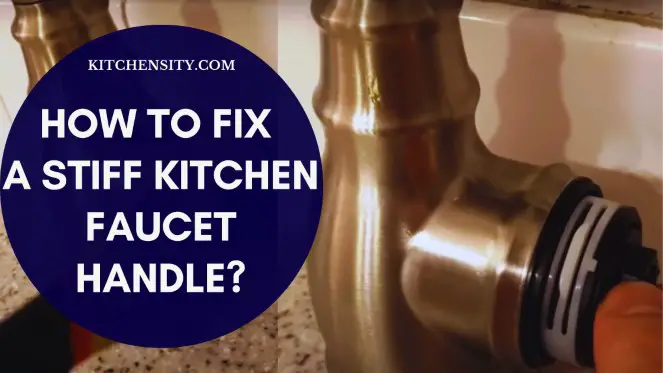
Great!
Thank you Katrina for teaching me how to remove this annoying faucet flow restrictor!
Exactly as you guide – very easy and pleasant work to do!
Now I have water actually running !
Eternally grateful :
G.
Thanks for the appreciation G.M. I am glad this article helped you to solve your problem. These comments motivate me to write more and more helpful content.